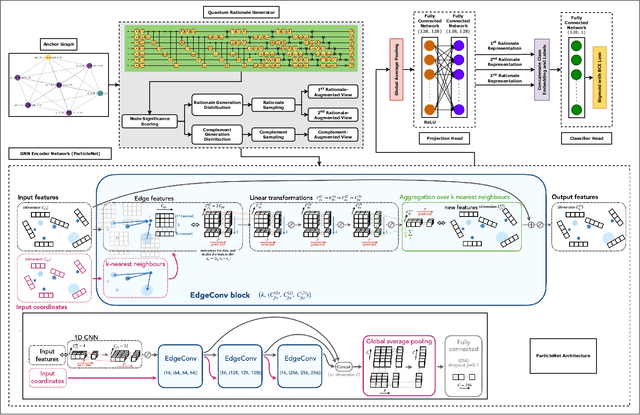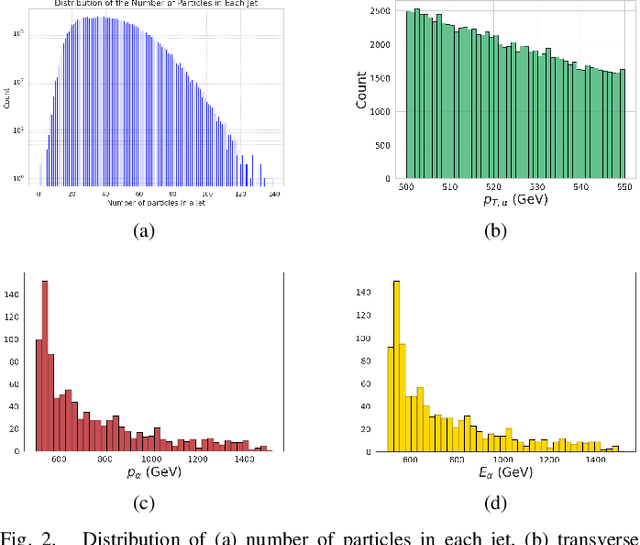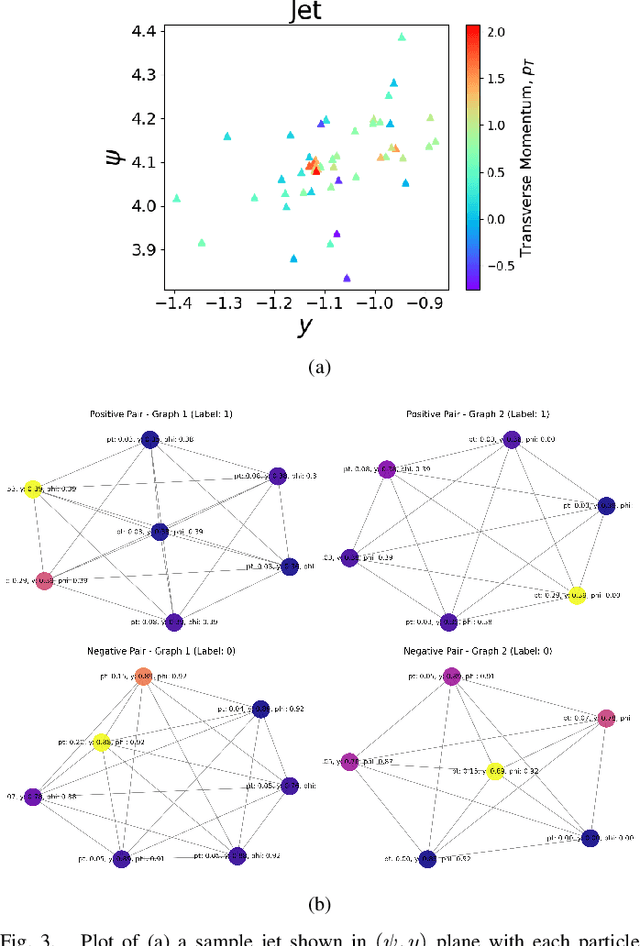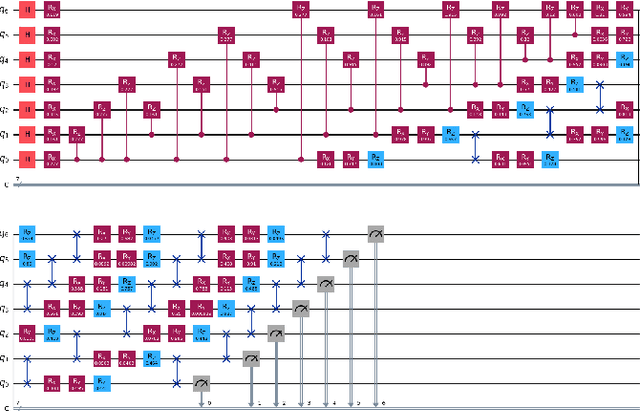Md. Akmol Masud
Quantum Rationale-Aware Graph Contrastive Learning for Jet Discrimination
Nov 03, 2024



Abstract:In high-energy physics, particle jet tagging plays a pivotal role in distinguishing quark from gluon jets using data from collider experiments. While graph-based deep learning methods have advanced this task beyond traditional feature-engineered approaches, the complex data structure and limited labeled samples present ongoing challenges. However, existing contrastive learning (CL) frameworks struggle to leverage rationale-aware augmentations effectively, often lacking supervision signals that guide the extraction of salient features and facing computational efficiency issues such as high parameter counts. In this study, we demonstrate that integrating a quantum rationale generator (QRG) within our proposed Quantum Rationale-aware Graph Contrastive Learning (QRGCL) framework significantly enhances jet discrimination performance, reducing reliance on labeled data and capturing discriminative features. Evaluated on the quark-gluon jet dataset, QRGCL achieves an AUC score of 77.53% while maintaining a compact architecture of only 45 QRG parameters, outperforming classical, quantum, and hybrid GCL and GNN benchmarks. These results highlight QRGCL's potential to advance jet tagging and other complex classification tasks in high-energy physics, where computational efficiency and feature extraction limitations persist.
Lorentz-Equivariant Quantum Graph Neural Network for High-Energy Physics
Nov 03, 2024



Abstract:The rapid data surge from the high-luminosity Large Hadron Collider introduces critical computational challenges requiring novel approaches for efficient data processing in particle physics. Quantum machine learning, with its capability to leverage the extensive Hilbert space of quantum hardware, offers a promising solution. However, current quantum graph neural networks (GNNs) lack robustness to noise and are often constrained by fixed symmetry groups, limiting adaptability in complex particle interaction modeling. This paper demonstrates that replacing the Lorentz Group Equivariant Block modules in LorentzNet with a dressed quantum circuit significantly enhances performance despite using nearly 5.5 times fewer parameters. Our Lorentz-Equivariant Quantum Graph Neural Network (Lorentz-EQGNN) achieved 74.00% test accuracy and an AUC of 87.38% on the Quark-Gluon jet tagging dataset, outperforming the classical and quantum GNNs with a reduced architecture using only 4 qubits. On the Electron-Photon dataset, Lorentz-EQGNN reached 67.00% test accuracy and an AUC of 68.20%, demonstrating competitive results with just 800 training samples. Evaluation of our model on generic MNIST and FashionMNIST datasets confirmed Lorentz-EQGNN's efficiency, achieving 88.10% and 74.80% test accuracy, respectively. Ablation studies validated the impact of quantum components on performance, with notable improvements in background rejection rates over classical counterparts. These results highlight Lorentz-EQGNN's potential for immediate applications in noise-resilient jet tagging, event classification, and broader data-scarce HEP tasks.
KACQ-DCNN: Uncertainty-Aware Interpretable Kolmogorov-Arnold Classical-Quantum Dual-Channel Neural Network for Heart Disease Detection
Oct 09, 2024Abstract:Heart failure remains a major global health challenge, contributing significantly to the 17.8 million annual deaths from cardiovascular disease, highlighting the need for improved diagnostic tools. Current heart disease prediction models based on classical machine learning face limitations, including poor handling of high-dimensional, imbalanced data, limited performance on small datasets, and a lack of uncertainty quantification, while also being difficult for healthcare professionals to interpret. To address these issues, we introduce KACQ-DCNN, a novel classical-quantum hybrid dual-channel neural network that replaces traditional multilayer perceptrons and convolutional layers with Kolmogorov-Arnold Networks (KANs). This approach enhances function approximation with learnable univariate activation functions, reducing model complexity and improving generalization. The KACQ-DCNN 4-qubit 1-layered model significantly outperforms 37 benchmark models across multiple metrics, achieving an accuracy of 92.03%, a macro-average precision, recall, and F1 score of 92.00%, and an ROC-AUC score of 94.77%. Ablation studies demonstrate the synergistic benefits of combining classical and quantum components with KAN. Additionally, explainability techniques like LIME and SHAP provide feature-level insights, improving model transparency, while uncertainty quantification via conformal prediction ensures robust probability estimates. These results suggest that KACQ-DCNN offers a promising path toward more accurate, interpretable, and reliable heart disease predictions, paving the way for advancements in cardiovascular healthcare.
 Add to Chrome
Add to Chrome Add to Firefox
Add to Firefox Add to Edge
Add to Edge